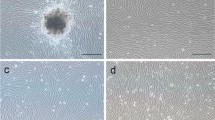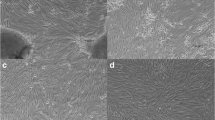Abstract
A new cell line was established from the heart of a cultured marine fish, half smooth tongue sole (Cynoglossus semilaevis), designated as CSH (Cynoglossus semilaevis heart cell line). The CSH cells grow over 400 days in minimum essential medium (MEM) supplemented with 10% fetal bovine serum (FBS) and 2 ng/ml basic fibroblast growth factor (bFGF). The suitable temperature for the cell growth was 24–30°C with the optimum growth at 24°C and a reduced growth at 12 and 30°C. FBS and bFGF concentration were the two important components for CSH cells proliferation. Twenty percent FBS in the medium was found to be the optimum concentration and bFGF promoted the growth of CSH cells. The double time of the cells at 24°C was determined to 73.39 h. Chromosome analysis revealed that 44% of the cells maintained a normal diploid chromosome number (2n = 42) in the CSH cells at Passage 58. The fluorescent signals were observed in CSH after the cells were transfected with green fluorescent protein (GFP) reporter plasmids. CSH cells showed the cytopathic effect (CPE) after infection with lymphosystis disease virus (LCDV). Moreover, the LCDV particles can be observed in the cytoplasm of virus-infected cells by electron microscopy, and a segment of MCP gene for major capsid protein of LCDV was found by PCR amplification DNA of virus-infected cells.









Similar content being viewed by others
References
Alonso MC, Ferro P, Garcia-Rosado E, Cano I, Lang T, Bergmann SM, Borrego JJ (2007) Comparison of lymphocystis disease virus (LCDV) isolates obtained from different marine fish species and geographical areas. Bull Eur Assoc Fish Pathol 27:157–164
Bahich H, Borenfreund E (1991) Cytotoxicity and genotoxicity assays with cultured fish cells: a review. Toxic Vitro 5:91–100
Bejar J, Porta J, Borrego JJ, Alvarez MC (2005) The piscine SAF-1 cell line: genetic stability and labeling. Mar Biotech 7:389–395
Bols NC, Dayeh VR, Lee LEJ, Schirmer K (2005) Use of fish cell lines in the toxicology and ecotoxicology of fish. In: Moon TW, Mommsen TP (eds) Biochemistry and molecular biology of fishes -environmental toxicology, vol. 6. Elsevier, Amsterdam, pp 43–84
Bradford CS, Sun L, Barnes DW (1994) Basic fibroblast growth factor stimulates proliferation and suppresses melanogenesis in cell cultures derived from early zebrafish embryos. Mol Mar Biol Biotech 3:78–86
Chen SC, Hu WW, Lo BJ (1999) Establishment and characterization of a continuous cell line (GF-1) derived from grouper, Epinephelus coioides: a cell line susceptible to grouper nervous necrosis virus (GNNV). J Fish Dis 22:173–182
Chen SL, Ye HQ, Sha ZX, Hong Y (2003a) Derivation of a pluripotent embryonic cell line from red sea bream blastulas. J Fish Biol 63:795–805
Chen SL, Sha ZX, Ye HQ (2003b) Establishment of a pluripotent embryonic cell line from sea perch (Lateolabrax japonicus) blastula embryo. Aquaculture 218:141–151
Chen SL, Ren GC, Sha ZX, Shi CY (2004) Establishment of a continuous embryonic cell line from Japanese flounder for virus isolation. Dis Aqua Org 60:241–246
Chen SL, Sha ZX, Ye HQ, Liu Y, Tian YS, Hong Y, Tang QS (2007) Pluripotency and chimera competence of an embryonic stem cell line from sea perch (Lateolabrax japonicus). Mar Biotech 9:82–91
Freshney RI (1994) Culture of animal cells. In: Freshney RI (ed) A manual of basic techniques. Wiley, New York, pp 387–389
Fryer JL, Lannan CN (1994) Three decades of fish cell culture: a current listing of cell lines derived from fishes. J Tiss Cult Meth 16:87–94
Halaban R, Langdon R, Birchall N, Cuono C, Baird A, Scott G, Moellman G, McGuire J (1988) Basic fibroblast growth factor from human keratinocytes is a natural mitogen for melanocytes. J Cell Biol 107:1611–1619
Hayflick L (1973) Theory of population increase by subcultivation. In: Kruse PF, Patterson MK (eds) Tissue culture methods and application. Academic Press, NY, pp 222–223
Hightower LH, Renfro JL (1988) Recent applications of fish cell culture to biomedical research. J Exp Zool 248:290–302
Hong Y, Schartl M (1996) Establishment and growth responses of early medaka fish embryonic cells in feeder layer-free cultures. Mol mar biol biotech 5:93–104
Hsu YL, Yang YH, Chen YC, Tung MC, Wu JL, Engelking MH, Leong JC (1995) Development of an in vitro subculture system for the oka organ (Lymphoid tissue) of Penaeus monodon. Aquaculture 136:43–55
Lee LEJ, Dayeh VR, Schirmer K, Bols NC (2009) Application and potential uses of fish gill cell lines: examples with RTgill-W1. In Vitro Cell Dev Biol Anim 45:127–134
Levan A (1964) Nomenclature for centromeric position on chromosomes. Hereditas 52:210–220
Matsui Y, Zsebo K, Hogan BLM (1992) Derivation of pluripotential embryonic stem cell line from murine primordial germ cells in culture. Cell 70:41–847
Nicholson BL, Danner DJ, Wu JL (1987) Three new continuous fish continuous cell lines from marine fishes of Asia. Vitro Cell Dev Biol 23:199–204
Parameswaran V, Ishaq Ahmed VP, Ravi S, Bhonde RR, Sahul Hameed AS (2007a) Development and characterization of two new cell lines from milkfish (Chanos chanos) and grouper (Epinephelus coioides) for virus isolation. Mar Biotechnol 9:281–291
Parameswaran V, Shukla R, Blonde R, Hameed AS (2007b) Development of a pluripotent ES-like cell line from Asian sea bass (Lates calcarifer)—an oviparous stem cell line mimicking viviparous ES cells. Mar Biotechnol 9:766–775
Ren GC, Chen SL, Sha ZX (2008) Development and characterization of a liver cell line from half-smooth tongue sole (Cynoglossus semilaevis). Chin High Technol Lett 18(6):657–660
Segner H (1998) Fish cell lines as a tool in aquatic toxicology. In: Braunbeck T, Hinton DE, Streit B (eds) Fish ecotoxicology. Birkhäuser, Basel, pp 1–38
Sha ZX, Ren GC, Wang XL, Wang N, Chen SL (2010) Development and characterization of a cell line from the embryos of half smooth tongue sole (Cynoglossus semilaevis). Chin Acta Oceanologica Sinica (in press)
Villena AJ (2003) Applications and needs of fish and shellfish cell culture for disease control in aquaculture. Rev Fish Biol Fisher 13:111–140
Wan RJ, Jiang YW, Zhuang ZM (2004) Morphological and development characters at the early stages of the tonguefish Cymoglossus semilaevis. Acta Zool Sinlca 50(1):91–102
Weissenberg R (1965) 50 Years of research on the lymphocystis virus disease of fishes (1914–1964). Ann N Y Acad Sci 126:362–374
Xu HT, Piao CA, Jiang ZL, Wang WX (2000) Study on the causative agent of lymphocystic disease in cultured flounder, Paralichthys Olivaceus, in mainland. China Chin Virol 16:223–226
Ye HQ, Chen SL, Sha ZX, Xu MY (2006) Development and characterization of cell lines from heart, liver, spleen and head kidney of sea perch Lateolabrax japonicus. J Fish Biol (Supplement A) 69:115–126
Zhou Lq, Yang Ag, Liu XZ, Du W, ZM Zhuang (2005) The karyotype of the tonguefish Cynoglossus semilaevis. J Fish China 29:417–419
Zhou GZ, Li ZQ, Yuan XP, Zhang QY (2007) Establishment, characterization, and virus susceptibility of a new marine cell line from red spotted grouper (Epinephelus akaara). Mar Biotech 9:370–376
Acknowledgments
This work was supported by grants from State 863 High-Technology R&D Project of China (2006AA09Z406, 2006AA10A401), and Taishan Scholar Project of Shandong Province.
Author information
Authors and Affiliations
Corresponding author
Rights and permissions
About this article
Cite this article
Wang, X.L., Wang, N., Sha, Z.X. et al. Establishment, characterization of a new cell line from heart of half smooth tongue sole (Cynoglossus semilaevis). Fish Physiol Biochem 36, 1181–1189 (2010). https://doi.org/10.1007/s10695-010-9396-5
Received:
Accepted:
Published:
Issue Date:
DOI: https://doi.org/10.1007/s10695-010-9396-5




